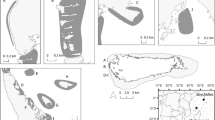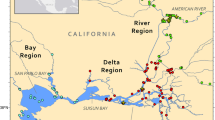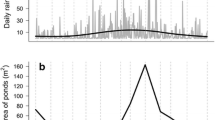Abstract
Movements of the wooly sculpin Clinocottus analis between all pools in a designated area of a southern California (USA) intertidal zone were studied. Fish were captured during low tides, finclipped or bead-tagged, and released in the pool of capture. Percent recaptured in pool of first capture declined from 30 after 2 weeks to about 5 after 20 weeks. Percent recaptured in any pool in the study area declined from 50 after 2 weeks to 20 after 8 weeks, but remained at 20 through 16 weeks. A higher fidelity to an area of the intertidal zone than to a specific pool was suggested. Large fish exhibited higher probability of recapture than smaller individuals, indicating they become more sedentary with age. Changes in pool topography influenced percent recurrence in a pool, most likely as a consequence of changes in quality and quantity of cover available. Such responses to changes in specific pools and fidelity to intertidal areas containing several pools appear to be advantageous behavioral patterns in an environment where topographic change is frequent and often massive.
Similar content being viewed by others
Literature Cited
Aronson, L.R.: Orientation and jumping behavior in the gobiid fish, Bathygobius soporator. Am. Mus. Novit. 1486, 1–22 (1951)
Beebe, W.: Notes on the gill-finned goby, Bathygobius soporator (Cuvier and Valenciennes). Zoologica, N.Y. 12, 55–56 (1931)
Gibson, R.N.: Studies on the movements of littoral fish. J. Anim. Ecol. 36, 215–234 (1967a)
— The use of the anesthetic quinaldine in fish ecology. J. Anim. Ecol. 36, 295–301 (1967b)
Green, J.M.: High tide movements and homing behaviour of the tidepool sculpin Oligocottus maculosus J. Fish. Res. Bd Can. 28, 383–389 (1971a)
— Local distribution of Oligocottus maculosus Girard and other tidepool cottids of the west coast of Vancouver Island, British Columbia. Can. J. zool 49, 1111–1128 (1971b)
Hubbs, C.: Fertilization, initiation of cleavage and developmental temperature tolerance of the cottid fish, Clinocottus analis. Copeia 1966, 29–42 (1966)
Nakamura, R.: Experimental assessment of factors influencing microhabitat selection by the two tidepool fishes Oligocottus maculosus and O. snyderi. Mar. Biol. 37, 97–104 (1976)
Richkus, W.A.: Aspects of the ecology of the wooly sculpin (Clinocottus analis Girard), 72 pp. Masters Thesis, University of California at San Diego, La Jolla, California 1968
Siegel, S.: Nonparametric statistics for the behavioral sciences, 312 pp. New York: McGraw Hill 1956
Williams, G.C.: Homing behavior of California rocky shore fishes. Univ. Calif. Publs Zool. 59, 249–284 (1957)
Author information
Authors and Affiliations
Additional information
Communicated by M.R. Tripp, Newark
Rights and permissions
About this article
Cite this article
Richkus, W.A. A quantitative study of intertidepool movement of the wooly sculpin Clinocottus analis . Marine Biology 49, 277–284 (1978). https://doi.org/10.1007/BF00391140
Accepted:
Issue Date:
DOI: https://doi.org/10.1007/BF00391140




